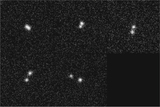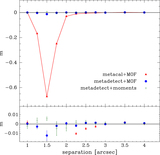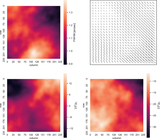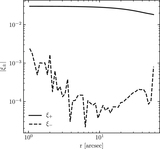Image Details

Caption: Figure 1.
Toy example of shear-dependent object detection in the presence of a PSF. In panel (a) two objects are present, convolved by a PSF with no shear. Contours represent constant brightness. In panel (b) the objects are sheared by γ = (0.0, 0.1) after the PSF convolution. The contour levels are the same as those of panel (a). In this case the inner contours for the two objects overlap before and after application of the shear. This is a general property of the shear transformation in the weak regime: surface brightness is preserved under shear, and because the mapping is one-to-one, the topology is also preserved. In panel (c) the shear is applied before the PSF convolution, which mimics real sky images. In this case the inner contours do not overlap after shearing, and two objects may be detected rather than one. For case (c) an object detection algorithm that identified connected regions above a threshold as a single object would manifest a shear-dependent object detection bias.
Copyright and Terms & Conditions
© 2020. The American Astronomical Society. All rights reserved.









